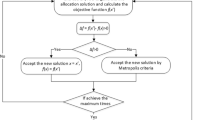Abstract
We consider the multi-period location planning problem of emergency medical service (EMS) stations. Our objective is to maximize the total population serviced by two distinct stations within two different response time limits over a multi-period planning horizon. Our aim is to provide a backup station in case no ambulance is available in the closer station and to develop a strategic plan that spans multiple periods. In order to solve this problem, we propose a Tabu Search approach. We demonstrate the effectiveness of the proposed approach on randomly generated data. We also implement our approach to the case of Istanbul to determine the locations of EMS stations in the metropolitan area.




Similar content being viewed by others
References
Andreatta G and Mason FM (1994). A note on a perfect forward procedure for a single facility dynamic location/relocation problem. Opns Res Lett 15: 81–83.
Badri MA, Mortagy AK and Alsayed A (1998). A multi-objective model for locating fire stations. Eur J Opl Res 110: 243–260.
Ballou RH (1968). Dynamic warehouse location analysis. J Market Res 5: 271–276.
Bastian M and Volkmer M (1992). A perfect forward procedure for a single facility dynamic location/relocation problem. Opns Res Lett 12: 11–16.
Başar A, Çatay B and Ünlüyurt T (2009a). A backup double covering model and Tabu Search solution approach for locating emergency medical stations. Working Paper/Technical Report, Sabanci University, ID:SU_FENS_2009/0001.
Başar A, Çatay B and Ünlüyurt T (2009b). A new model and Tabu Search approach for planning the emergency service stations. In: Fleischmann B, Borgwardt KH, Klein R and Tuma A (eds). Operations Research Proceedings 2008: Selected Papers of the Annual International Conference of the German Operations Research Society (GOR), University of Augsburg. Springer-Verlag: Berlin, pp. 41–46.
Berman O and Krass D (2002). The generalized maximal covering location problem. Comput Opns Res 29: 563–581.
Brotcorne L, Laporte G and Semet F (2003). Ambulance location and relocation models. Eur J Opl Res 147: 451–463.
Chardaire P, Sutter A and Costa M (1996). Solving the dynamic facility location problem. Networks 28: 117–124.
Church RL and ReVelle CS (1974). The maximal covering location problem. Papers of the Regional Science Association 32: 101–118.
Current J, Ratick S and ReVelle C (1997). Dynamic facility location when the total number of facilities is uncertain: A decision analysis approach. Eur J Opl Res 110: 597–609.
Da Gama FS and Captivo ME (1998). A heuristic approach for the discrete dynamic location problem. Locat Sci 6: 211–223.
Daskin MS (1983). A maximum expected covering location model: Formulation, properties and heuristic solution. Transport Sci 7: 48–70.
Doerner KF, Gutjahr WJ, Hartl RF, Karall M and Reimann M (2005). Heuristic solution of an extended double-coverage ambulance location problem for Austria. Cent Eur J Opns Res 13: 325–340.
Drezner Z (1995). Dynamic facility location: The progressive p-median problem. Locat Sci 3: 1–7.
Drezner Z and Wesolowsky GO (1991). Facility location when demand is time dependent. Nav Res Log 38: 763–777.
Frantzeskakis M and Watson-Gandy CDT (1989). The use of state space relaxation for the dynamic facility location problem. Ann Opns Res 18: 189–212.
Gendreau M, Laporte G and Semet F (1997). Solving an ambulance location model by tabu search. Locat Sci 5: 75–88.
Gendreau M, Laporte G and Semet F (2001). A dynamic model and parallel tabu search heuristic for real time ambulance relocation. Parallel Comput 27: 1641–1653.
Glover F (1977). Heuristics for integer programming using surrogate constraints. Decision Sci 8: 156–166.
Glover F (1990). Tabu search: A tutorial. Interfaces 20(4): 74–94.
Goldberg JB (2004). Operations research models for the deployment of emergency services vehicles. EMS Mngt J 1: 20–39.
Harewood SI (2002). Emergency ambulance deployment in Barbados: A multi-objective approach. J Opl Res Soc 53: 185–192.
Hogan K and ReVelle CS (1986). Concepts and applications of backup coverage. Mngt Sci 34: 1434–1444.
Lodish LM (1970). Computational limitations of dynamic programming for warehouse location. J Market Res 7: 262–263.
Marianov V and ReVelle CS (1995). Siting emergency services. In: Drezner Z (ed). Facility Location. Springer: New York, pp. 199–223.
Rajagopalan HK, Saydam C and Xiao J (2008). A multi-period set covering location model for dynamic redeployment of ambulances. Comput Opns Res 35: 814–826.
Repede JF and Bernardo JJ (1994). Developing and validating a decision support system for locating emergency medical vehicles in Louisville, Kentucky. Eur J Opl Res 75: 567–581.
Rosenblatt MJ (1986). The dynamics of plant layout. Mngt Sci 32: 76–86.
Schilling DA (1980). Dynamic location modeling for public sector facilities: A multicriteria approach. Decision Sci 11: 714–724.
Scott AJ (1971). Dynamic location–allocation systems: Some basic planning strategies. Environ Plann 3: 73–82.
Warszawski (1973). Multi-dimensional location problems. Opns Res Quart 24: 165–179.
Wesolowsky GO (1973). Dynamic facility location. Mngt Sci 19: 1241–1248.
Wesolowky GO and Truscott WG (1975). The multi-period location–allocation problem with relocation of facilities. Mngt Sci 22: 57–65.
Acknowledgements
We thank the managers and personnel of the Directorate of Instant Relief and Rescue at the Istanbul Metropolitan Municipality for their valuable collaboration in collecting the data and sharing their ideas. We are grateful to the Directorate of Strategic Planning at the Istanbul Metropolitan Municipality for supporting this research. We also thank the two anonymous referees for their constructive comments.
Author information
Authors and Affiliations
Corresponding author
Rights and permissions
About this article
Cite this article
Başar, A., Çatay, B. & Ünlüyurt, T. A multi-period double coverage approach for locating the emergency medical service stations in Istanbul. J Oper Res Soc 62, 627–637 (2011). https://doi.org/10.1057/jors.2010.5
Received:
Accepted:
Published:
Issue Date:
DOI: https://doi.org/10.1057/jors.2010.5




